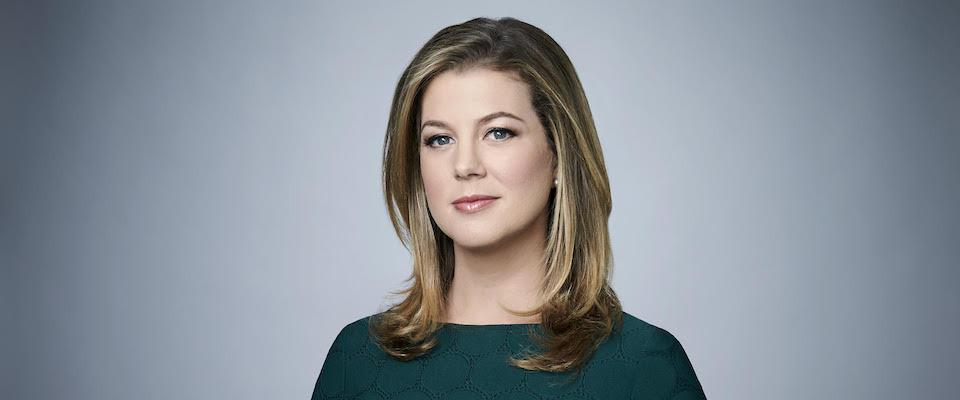As she was covering the 2016 presidential election, CNN correspondent Brianna Keilar didn’t expect to become part of the story. But that August, her exchange with Trump Organization attorney Michael Cohen made headlines.
“You guys are down,” Keilar tells him in the segment, referring to Trump campaign. Before she can finish her sentence, Cohen interrupts: “Says who?”
“Polls,” she responds.
“Says who?”
“Polls. Most of them. All of them?”
A pause ensues.
“Says who?”
The interview went viral, and Keilar briefly became a hero in some camps for standing up for truth in a climate of “alternative facts.” Pointing out falsehoods is important to Keilar, who covers critical political and policy stories as CNN’s senior Washington correspondent. During the election, she led the network’s coverage of Hillary Clinton’s presidential campaign. Previously, she reported on the Obama administration as CNN’s White House correspondent and on the legislature as a congressional correspondent. Keilar graduated from UC Berkeley in 2001 and majored in psychology and mass communications (now called media studies).
I talked with Keilar about going viral, what it’s like to cover Washington today, and why she’s decided to share her personal life with viewers. Our conversation has been edited for length and clarity.
You’ve talked about journalism reflecting your values of service, duty, and responsibility. When did you know you wanted to be a journalist, and what drew you to it, particularly the TV side?
I recently found a scholarship application from when I was in high school where I said I wanted to go into TV news. At the time, I was a sports reporter for our bimonthly news magazine. It was more of a pipe dream then but became more realistic in college, though it still seemed a little far-fetched. Dennis Richmond, the main anchor at KTVU News in San Francisco, came to speak to our class on mass communications. I ended up interning there. I realized they had really high journalistic standards. And I loved the visual aspect of it: You’re not only putting people in your story, but you’re getting them on camera. I remember shadowing reporters on stories where people had lost loved ones or were just concerned about an issue. For me, it really did feel like a service to get a story out there and give voice to people who would otherwise not have one.
You reported on the Obama administration for many years as a White House correspondent. What’s different about covering the current administration?
I’m now the Washington correspondent, so I don’t cover the White House with as much proximity. During the Obama administration, we’d complain a lot about not having enough access. Events weren’t always on the calendar, so we wouldn’t be able to get a camera in. There are lots of opportunities to see President Trump do things on camera. He speaks a lot and answers a lot of questions daily, not to mention going on Twitter. He’s open about what his thoughts are and there’s really no filter. On one hand you have this free flow of information, but on the other hand he says things that are not true.
The pace is also exponentially faster. The press corps as a whole has a lot more work and is constantly moving from one thing to the next. A story that would normally percolate for a day or two now might last for an hour or two before something big pops up. People are working on overdrive, but this is also what we thrive on.
Speaking of truth, you went viral during the 2016 presidential campaign for your exchange with Cohen, the Trump Organization attorney. Why do you think this segment got so much attention? And how do you see your role in terms of pushing back against falsehoods when you risk being seen as taking a side?
I think it encapsulated a moment in which campaign surrogates were saying, “This is orange,” when we could see it was blue. That day, I had looked at all the national polls. Literally every single one was in Hillary Clinton’s favor. It was math, yet someone was still arguing with the fact. Looking back at that moment on election night, I had a different perspective. The national polls had her ahead, but it wasn’t necessarily what mattered. It was stunning how she won the popular vote, yet Donald Trump ran away with the Electoral College.
We are on the side of truth. We push back on Democrats, and we push back on Republicans. In the current news environment, live fact checking has become extremely important. If you’re writing an article, it’s easy to figure out whether there’s more to the story or it’s patently false, but it’s hard to call someone out on the fly. My colleagues and I have had to up our game to make sure we can do our best to do that.
You led CNN’s coverage of Hillary Clinton’s 2016 presidential campaign. Given her loss despite what every poll was predicting, would you have covered her campaign differently in any way?
No. I don’t think thinking she would win was a basis for how we covered her. It wasn’t really relevant. To this day, I talk to supporters who feel upset that her email situation was covered the way it was. I say to them, “She set up a personal email account and housed it in a server in her basement. That’s not OK, and that deserved to be covered.” If the media had known what we know now about the extent of Russian meddling, how social media was used in such a savvy way, and how racial divisions were exploited, we would’ve of course covered it differently. But you can always say that in retrospect.
We’re hearing a lot these days about the challenges and dangers women can face on the job, from Hollywood to politics to the media. What has it been like for you as a woman reporter in the boys’ club of politics and the D.C. press?
This is a conversation that every woman is having with her friends. I feel lucky in that I have never experienced harassment in a professional environment. It feels like the country is crossing the Rubicon on this issue. Behavior that was somehow hidden or acceptable before is no longer acceptable. I’m awestruck in the same way so many people are. I’m so upset thinking about how harrowing it must’ve been for young women trying to break into an industry. I think it’s so brave and important for women to stand up and hopefully help those that are younger.
Women are such a thriving part of the Washington press corps, and I think we’re well-represented among the most talented. They are often juggling things that I don’t think the guys are, but I think it makes them better at getting everything done. There are always going to be guys who feel it’s a boys’ club, but the challenges we face are significantly lesser than the previous generation of women in journalism. There’s always progress to be made, but we’ve come a long way.
You wrote a personal piece about a man who tweeted that “U and other media R in a bubble & don’t know real people” after you posted about watching Taking Chance, a film based on the true story of a Marine transporting his friend’s body home from the Iraq War. The comment hit a nerve because your husband is an Army Special Forces officer on his sixth deployment. How often do face vitriol on social media, and how do you deal with it?
I do read comments, but sometimes I ignore them because I’ve hit my limit. A lot of people on Twitter are just hating, without even watching what’s going on on TV. But there are a lot of nice people on Twitter too. If someone is using really bad language, occasionally I’ll highlight it and let Twitter have its way. Mostly I just skip by and don’t pay attention. In this case, I felt like the guy was criticizing me for not watching a movie sooner yet had no idea I was sitting there watching it alone because my husband was gone. I wanted to make the point that it’s easy to make assumptions about people. I was floored that he apologized in the fullest terms. That reminded me that a lot of people enjoy the cloak of anonymity on social media but actually aren’t terrible people.
In addition to the personal article about your husband, you appeared in a CNN video series called “Girls on the Bus” that profiled the network’s women journalists covering the 2016 election. You shared the tragic story of your mom dying within 24 hours of you learning she had acute leukemia, while you were on the campaign trail. You also shared a much happier, but still intimate, moment of planning your wedding. Why did you want to share such personal, behind-the-scenes stories, when anchors and correspondents have traditionally been these removed, larger-than-life figures?
You don’t want to become the story, and I think you want to bring in the personal side sparingly. But given the relationship that President Trump had with the press, we became part of the story. And viewers are interested in what it’s like to cover a campaign. For me, being truthful about what it was like covering the campaign meant I had to share what it was like to lose arguably the most important person in my life. I was shocked when I lost my mom so quickly—I didn’t even know that could happen. But I got responses on Twitter, email and in person from people telling similar stories. Doing that story made me feel like I really connected with viewers, and the response felt productive and soothing.
We’re used to compartmentalizing as journalists. With some stories, you couldn’t do your job of giving people information if you were having a totally normal human reaction. A couple of weeks ago, I was anchoring on CNN when John Kelly, the White House chief of staff, stepped up to the podium in the briefing room and talked about losing his son in Afghanistan. I couldn’t really steel myself because it was a surprise. I was on the razor’s edge of not keeping it together. I decided to write about it the following week because the conversation about Gold Star families had become so divisive. I thought I had something to add to the conversation from a military family perspective.



















